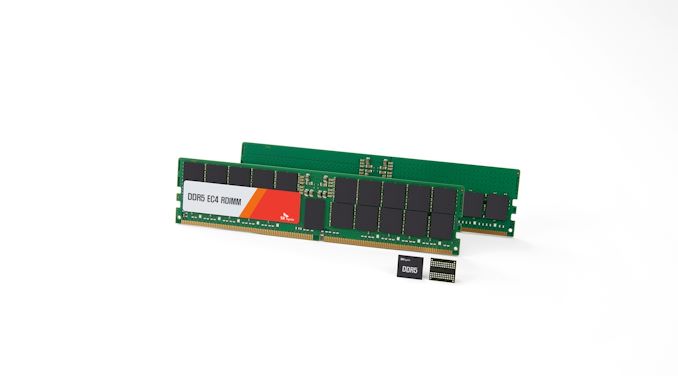SK Hynix to Manufacture 48 GiB and 96 GiB DDR5 Modules
by Dr. Ian Cutress on December 14, 2021 8:37 PM EST
Today SK Hynix is announcing the sampling of its next generation DDR5 memory. The headline is the commercialization of a new 24 gigabit die, offering 50% more capacity than the leading 16 gigabit dies currently used on high-capacity DDR5. Along with reportedly reducing power consumption by 25% by using SK Hynix’s latest 1a nm process node and EUV technology, what fascinates me most is that we’re going to get, for the first time in the PC space (to my knowledge), memory modules that are no longer powers of two.
For PC-based DDR memory, all the way back from DDR1 and prior, memory modules have been configured as a power of two in terms of storage. Whether that’s 16 MiB to 256 MiB to 2 GiB to 32 GiB, I’m fairly certain that all of the memory modules that I’ve ever handled have been powers of two. The new announcement from SK Hynix showcases that the new 24 gigabit dies will allow the company to build DDR5 modules in capacities of 48 GiB and 96 GiB.
To be clear, the DDR5 official specification actually allows for capacities that are not direct powers of two. If we look to other types of memory, powers of two have been thrown out the window for a while, such as in smartphones. However PCs and Servers, as least the traditional ones, have followed the power of two mantra. One of the changes in memory design that is now driving regular modules to non-power of two capacities is that it is getting harder and harder to scale DRAM capacities. The time it takes to figure out the complexity of the technology to get a 2x improvement every time is too long, and memory vendors will start taking those intermediate steps to get product to market.
In traditional fashion though, these chips and modules will be earmarked for server use first, for ECC and RDIMM designs. That’s the market that will absorb the early adopter cost of the hardware, and SK Hynix even says that the modules are expected to power high performance servers, particularly in machine learning as well as other HPC situations. One of the quotes on the SK Hynix press release was from Intel’s Data Center Group, so if there is any synergy related to support and deployment, that’s probably the place to start. A server CPU with 8x 64-bit channels and 2 DIMMs per channel gives 16 modules, and 16 x 48 GiB enables 768 GiB capacity.
As to when this technology will come to the consumer market, we’re going to have to be mindful of cost and assume that these chips will be used on high-cost hardware. So perhaps 48 GiB UDIMMs will be the first to market, although there’s a small possibility 24 GiB UDIMMs might make an appearance. Suddenly that 128 GiB limit on a modern gaming desktop will grow to 192 GiB.
Source: SKHynix Newsroom










22 Comments
View All Comments
Dolda2000 - Wednesday, December 15, 2021 - link
Any word on what part of the address is "absorbing" the non-power-of-two? I'd have to guess it's an odd number of bank groups, but who knows what kinds of shenanigans they may be up to.dwillmore - Wednesday, December 15, 2021 - link
No amount of integer multiplication is going to get rid of a factor of three in a value.